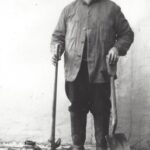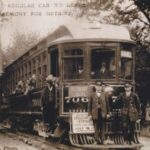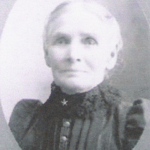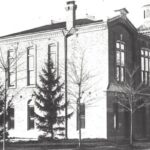Almont schools and fire have a lengthy history.
The most interesting and controversial fire occurred April 18, 1927. The school district was in turmoil over several issues before the fire and it was feared that the fire had been “set.”
The story actually begins in February of 1927 when Doane Black was hired as a teacher. He immediately tried to increase the scholarship standards for the school. It is an assumption that his grading scale was stricter than the other teachers. The students and their parents did not like the higher standards and expressed their displeasure to Mr. Black, superintendent Everett Romine Bristol, and members of the school board. At about the same time, a young lady started school at Almont. She had been in trouble and was attending school at the Girl’s Training School in Adrian. She had been paroled and came to live with her sister in Almont. Several parents expressed their concerns to the superintendent. They felt that she would be a bad moral influence on the other students.
Many of these parents were members of the Baptist Church and three of the five school board members were also members of the Baptist Church. Eventually some of these parents asked the superintendent to exclude the young lady from school. Superintendent Bristol refused to exclude the girl. His explanation to the parents was that there was no legal reason to do so. The girls conduct and school work were all of acceptable levels and only for those reasons would he exclude her. The superintendent did have a physician from the state health department make an examination of the girl and of certain other pupils. This action only added to the criticism about the girl’s presence.
On March 16, 1927, the school board passed a motion to extend Mr. Bristol’s contract to cover the 1927-1928 school year. However, they did not actually have a contract ready for approval. A few days later, the school board met because of the turmoil surrounding Mr. Black and the young lady. At that meeting, the school board rescinded its offer to Mr. Bristol and passed a motion to hire Mr. Black as superintendent for the 1927-1928 school year.
About this time, an employee of the Girls’ Training School had come and taken the young lady back to Adrian. She was there only a few days before she was released. She had completed her sentence. Upon returning to Almont, she did not return to school. Several persons who wanted to allay the agitation of the girl’s presence at school had asked her sister and her mother, who lived in Imlay City, to keep her out of school. The women agreed and the girl did not return.
On Tuesday, April 12, 1927, the high school students, except the seniors, staged a strike. They made banners praising Mr. Bristol and ones attacking Mr. Black and certain school board members. They then left school and marched downtown. Several members of the band lead them while they played a tune popular at the time, “Bye, Bye Blackbirds.” There was a report that some of the students actually when to Romeo and also marched there.
The next night, Wednesday, April 13, 1927, the school board met to discuss the trouble that was disrupting the school. After a lengthy and heated discussion, the school board persuaded the superintendent, Mr. Bristol; the high school principal, Mrs. Eunice Hough Johnson; and two teachers; Miss Anna Hough and Mr. Black to resign immediately. Essentially, this was the entire high school staff. Mrs. Johnson was honored with a dedication in the 1922 yearbook, “The Quill”.
The next day, a story about the district’s troubles was carried on the front page of the Battle Creek Enquirer, so the turmoil had attracted statewide attention.
On Monday, April 18, 1927, school reopened with a new superintendent, A. T. Hagerman from Detroit; a new principal, Miss Tessie Sperry from Mayville; and a new science teacher, Merwin Starling of Bad Axe. A new languages teacher had not yet been employed. It is not known if any effort was made to hold classes on Thursday and Friday of the previous week. The day passed without incident and it was hoped the troubles were over and the school and town could move on without any further problems.

That evening, several people noted smelling smoke but could not find its origin. Among those was Alfred Walker, the school’s custodian, who lived on North Main Street. About 9 pm, G. W. Anderson discovered the fire in the basement of the school but there were also fires on the second floor.
The fire alarm was sounded and the firemen responded under the leadership of Fire Chief Charles E. Lewis. Upon entering the basement, the firemen smelled an odor of kerosene. Mr. Walker arrived and went to the basement to retrieve a can of kerosene which he had purchased that morning. He threw it out of the basement but did not determine if any of it had been used. The firemen noted that the furnace was not lit. The fire was so intense and extensive that other local fire departments were called to assist. Romeo came with 20 men and Capac and Richmond brought 15 men each.
The first order of fighting the fire was to get the basement fires extinguished. Once the basement was under control, firemen got on the roof and the second floor to fight those fires. Just as they seemed to be getting those fires under control, one of Almont’s firemen, Cleo Keller became overcome with smoke and heat and had to be removed from the roof. The fires flared during this lull and the roof and second floor could not be saved. After six hours, the fire was finally controlled. Firemen remained on the scene until about noon on Tuesday to put out hot spots and watch materials that were smoldering.
The fire destroyed the basement, the second floor and roof. The first floor was less extensively damaged by the fire but suffered from water and smoke damage. Students were able to get into the rooms on the first floor and retrieve their damaged belongings. The school records were removed from the second floor offices almost immediately after the fire was discovered. Fire Chief Lewis on Tuesday said that the circumstances seemed to indicate unmistakably that the fire was intentionally set, but that there was no positive proof at that time. Both Sheriff Courter and the state police investigated the origin of the fire.




